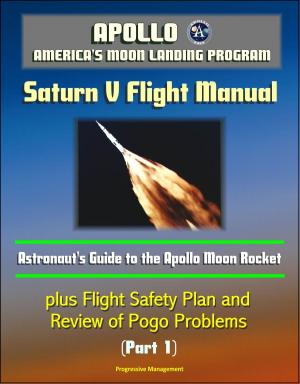Histories of the Soviet / Russian Space Program: Volume 2: Soviet Space Programs 1971 - Kosmos, Lunokhod, Salyut, Soyuz, Zond, FOBS, Military Satellites, Mars Attempts, Tracking Ships
Nonfiction, Science & Nature, Technology, Aeronautics & Astronautics, Science, Physics, Astrophysics & Space Science| Author: | Progressive Management | ISBN: | 9781301849376 |
| Publisher: | Progressive Management | Publication: | May 19, 2013 |
| Imprint: | Smashwords Edition | Language: | English |
| Author: | Progressive Management |
| ISBN: | 9781301849376 |
| Publisher: | Progressive Management |
| Publication: | May 19, 2013 |
| Imprint: | Smashwords Edition |
| Language: | English |
This fascinating and informative series of Soviet space program history reports continues with a reproduction of a truly historic document: Soviet Space Programs, 1971, converted for accurate flowing-text ebook format reproduction. The history of the Russian spaceflight effort is chronicled in these superb Congressional Research Service reports to Congress. The early reports were authored by a renowned Soviet space expert, the late Dr. Charles S. Sheldon. They provide an "as-it-happened" contemporaneous account of every element of the Soviet program: manned and unmanned programs, military satellite, launch sites, compendiums of official statements, plans, international participation and cosmonauts, and much more. Every student of space flight needs to have these important reports in their collection.
Small Kosmos (B-1) * Kapustin Yar scientific flights * Plesetsk military flights * Intermediate Kosmos (C-1) * Previous subsets for navigation and ferreting * New repetitive subsets * Multiple payloads * Scientific flights * Target flights * Military observation recoverable payloads (A-2) * More third generation flights * Observation programs since 1962 * D. Lunokhod 1 * Brief description of roving vehicle * Review of operational life * Scientific findings * Relative merits of manned versus unmanned roving lunar vehicles * The 1971 Mars attempts * Launch failures * Launch of Mars 2 and 3 and of Mariner 9 * Inflight progress * Mars 2 arrival * Mars 3 arrival * The landers * The orbital buses and their activity * Luna 18,19, and 20 * Luna 18 * Luna 1 * Luna 2 * Program details—manned * Precursors * Salyut and Soyuz 10 * Launch of Salyut * Launch of Soyuz 10 * New equipment in docking * Separation and recovery * Ground reception of crew * Possible flight difficulties * Soyuz 11 and Salyut * Launch of Soyuz 11 * Details on Salyut * Mission of Salyut * Summary of mission activity * Degree of success and possible problems * Separation and recovery * Deaths of the cosmonauts * Further work with Salyut * Zond manned precursors * Manned flight statistics * Soviet civil applications * Meteora * Kosmos 389 and Kosmos 405 * Communications satellites * Earth resources satellites * Soviet military applications * Military support flights * FOBS * Maneuverable satellites * Interceptor satellites for inspection/destruction * Other F-1-m maneuvering satellites * Three subsets * Difficulties of interception * A chronology of Soviet statements on future space plans * 1970 * 1971 * 1972 * Other developments * Soviet ground support * Moscow Space Institute, Soviet Academy of Sciences * Overseas land-based tracking station * Soviet tracking ships * The Kosmonavt Yuriy Gagarin * Soviet space personalities * Soviet international space cooperation * Lunar rock exchanges * Bilateral meetings with the United States * Bilateral activities with France * Interkosmos program * Vertikal probes * Draft space treaties
As a bonus, this ebook includes an official NASA document providing an interesting review of NASA's experience working with the Russians and lessons on astronaut safety assurance of the Soyuz spacecraft. This report on Soyuz history was conceived as a possible analogy relevant to domestic commercial spaceflight vehicles. The question of how to human-rate new spacecraft has been asked many times throughout the history of human spaceflight. The U. S., Russia, and, now China have each separately and successfully addressed this question. NASA's operational experience with human-rating primarily resides with Mercury, Gemini, Apollo, Space Shuttle, and the International Space Station (ISS). NASA's latest developmental experience includes Constellation, but also encompasses X38, X33, and the Orbital Space Plane.
This fascinating and informative series of Soviet space program history reports continues with a reproduction of a truly historic document: Soviet Space Programs, 1971, converted for accurate flowing-text ebook format reproduction. The history of the Russian spaceflight effort is chronicled in these superb Congressional Research Service reports to Congress. The early reports were authored by a renowned Soviet space expert, the late Dr. Charles S. Sheldon. They provide an "as-it-happened" contemporaneous account of every element of the Soviet program: manned and unmanned programs, military satellite, launch sites, compendiums of official statements, plans, international participation and cosmonauts, and much more. Every student of space flight needs to have these important reports in their collection.
Small Kosmos (B-1) * Kapustin Yar scientific flights * Plesetsk military flights * Intermediate Kosmos (C-1) * Previous subsets for navigation and ferreting * New repetitive subsets * Multiple payloads * Scientific flights * Target flights * Military observation recoverable payloads (A-2) * More third generation flights * Observation programs since 1962 * D. Lunokhod 1 * Brief description of roving vehicle * Review of operational life * Scientific findings * Relative merits of manned versus unmanned roving lunar vehicles * The 1971 Mars attempts * Launch failures * Launch of Mars 2 and 3 and of Mariner 9 * Inflight progress * Mars 2 arrival * Mars 3 arrival * The landers * The orbital buses and their activity * Luna 18,19, and 20 * Luna 18 * Luna 1 * Luna 2 * Program details—manned * Precursors * Salyut and Soyuz 10 * Launch of Salyut * Launch of Soyuz 10 * New equipment in docking * Separation and recovery * Ground reception of crew * Possible flight difficulties * Soyuz 11 and Salyut * Launch of Soyuz 11 * Details on Salyut * Mission of Salyut * Summary of mission activity * Degree of success and possible problems * Separation and recovery * Deaths of the cosmonauts * Further work with Salyut * Zond manned precursors * Manned flight statistics * Soviet civil applications * Meteora * Kosmos 389 and Kosmos 405 * Communications satellites * Earth resources satellites * Soviet military applications * Military support flights * FOBS * Maneuverable satellites * Interceptor satellites for inspection/destruction * Other F-1-m maneuvering satellites * Three subsets * Difficulties of interception * A chronology of Soviet statements on future space plans * 1970 * 1971 * 1972 * Other developments * Soviet ground support * Moscow Space Institute, Soviet Academy of Sciences * Overseas land-based tracking station * Soviet tracking ships * The Kosmonavt Yuriy Gagarin * Soviet space personalities * Soviet international space cooperation * Lunar rock exchanges * Bilateral meetings with the United States * Bilateral activities with France * Interkosmos program * Vertikal probes * Draft space treaties
As a bonus, this ebook includes an official NASA document providing an interesting review of NASA's experience working with the Russians and lessons on astronaut safety assurance of the Soyuz spacecraft. This report on Soyuz history was conceived as a possible analogy relevant to domestic commercial spaceflight vehicles. The question of how to human-rate new spacecraft has been asked many times throughout the history of human spaceflight. The U. S., Russia, and, now China have each separately and successfully addressed this question. NASA's operational experience with human-rating primarily resides with Mercury, Gemini, Apollo, Space Shuttle, and the International Space Station (ISS). NASA's latest developmental experience includes Constellation, but also encompasses X38, X33, and the Orbital Space Plane.















